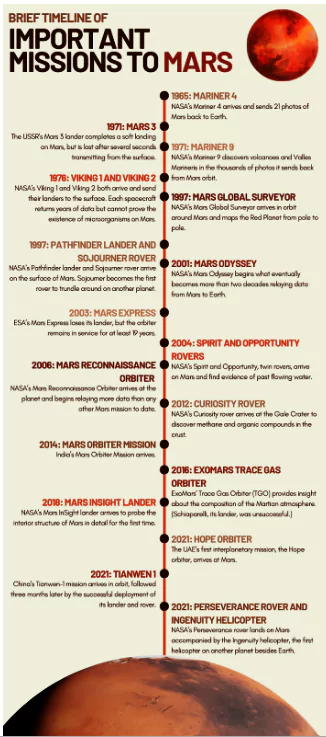A recent paper released determines how often meteorites impact the surface of Mars from seismological data from Nasa’s InSight probe.
Meteorites strikes on Mars, About The Study
- Published in: The study is published in the journal Nature Astronomy
- Source of data: The researchers used the data from NASA’s Mars probe InSight’s seismometer which could hear every single impact within the landers’ range.
 Process:
Process: -
- The scientists tracked a particular acoustic signal which is produced when meteorites strike Mars to estimate the diameter of craters and their distance from InSight.
- They then calculated the number of craters made in one year near the lander, before extrapolating that number across the entire planet.
- Approach: The study’s approach was to listen to the internal rumblings of the red planet when the meteorites striked rather than the previous approach of estimating the strike rate by images taken by orbiting spacecraft or models based on craters on the Moon.
- Listening for impacts seems to be more effective than looking for them if we want to understand how often they occur.
- Finding: It is estimated that Mars is hit by 280 to 360 meteorites every year, all of which blast craters bigger than eight metres (26 feet) wide.
- This rate was about five times higher than the number estimated from orbital imagery alone.
- Also it was estimated that a big meteorite strike makes a 30-metre crater on Mars about once a month.
- Significance:
- Future Missions: This data is definitely a valuable source for mapping mars which will be an invaluable source when it comes to plan for future missions to Mars.
- Shortcoming of the imagery approach: Frequent, intense dust storms on Mars makes it particularly difficult for spacecraft orbiting Mars to see small meteorite craters down below.
Enroll now for UPSC Online Course
Why is Mars a Prime Target?
- Closer to the asteroid Belt: Mars is roughly twice as big as the Moon and is much closer to our solar system’s main asteroid belt, thus being a prime target for large rocks hurtling through space.
- Thin Atmosphere: Martian atmosphere is 100 times thinner than Earth thus the Meteorites does not break apart in its atmosphere like it does on Earth giving it little protection.
Meteorites
- A meteorite is a solid piece of debris originating from an object, such as a comet, asteroid, or meteoroid, that originates in outer space and survives its passage through the atmosphere to reach the surface of a planet or moon
- Origin: Most meteorites are believed to originate in the asteroid belt between Mars and Jupiter, and were formed early in the history of the Solar System ~4.56 billion years ago.
- Types: Meteorites are divided into groups according to their structure, chemical and isotopic composition and mineralogy.
- Stony meteorites: They are rocks, mainly composed of silicate minerals
- Iron meteorites: They are largely composed of metallic iron-nickel
- Stony -iron meteorites: It contains large amounts of both metallic and rocky material.
Difference between a Meteor, Meteorite and Meteoroid
- Meteoroids: These rocks are still in space. Meteoroids range in size from dust grains to small asteroids.
- Meteors: When meteoroids enters the atmosphere of a planet, like Earth or Mars at high speed and burn up, the fireballs or “shooting stars” are called meteors.
- Meteor Shower: An estimate of about 48.5 tons or 44,000 kilograms of meteoritic material falls on Earth each day. Almost all the material is vaporized in Earth’s atmosphere, leaving a bright trail fondly called “shooting stars”.
- Meteorites: When a meteoroid survives a trip through the atmosphere and hits the ground, it’s called a meteorite.
|
About Mars
- Mars is the seventh largest planet in our solar system with a radius of 2,106 miles, and about half the diameter of Earth.
- Its surface gravity is 37.5 percent of Earth’s.
- Rotation: Mars rotates on its axis,(which is tilted at 25.2 degrees) every 24.6 Earth hours, defining the length of a Martian day, which is called a sol.
- One Martian Year: A year lasts 669.6 sols, or 687 Earth days, and an individual season can last up to 194 sols, or just over 199 Earth days.
- Atmosphere: Mars has a far thinner atmosphere (mostly made of carbon dioxide, nitrogen, and argon) than Earth which dramatically lessens how much heat the planet can trap near its surface.
- Air pressure atop Mount Everest is about 50 times higher than it is at the Martian surface.
- Surface temperatures: Temperatures can reach as high as 70 degrees Fahrenheit and as low as -225 degrees Fahrenheit, but on average, its surface is -81 degrees Fahrenheit, a full 138 degrees colder than Earth’s average temperature.
- Protective barrier: Mars lacks an active plate tectonic system and a planetary magnetic field making it easier for the sun’s high-energy particles to strip away the red planet’s atmosphere.
NASA’s InSight (Interior Exploration using Seismic Investigations, Geodesy and Heat Transport) Lander
- Operational from: InSight was operational on Mars from November 2018 until December 2022.
- Objective: NASA’s InSight spacecraft studied Mars’ interior and Marsquakes to learn how other worlds, including Earth-like exoplanets around other stars, evolve.
|
![]() 29 Jun 2024
29 Jun 2024
 Process:
Process: